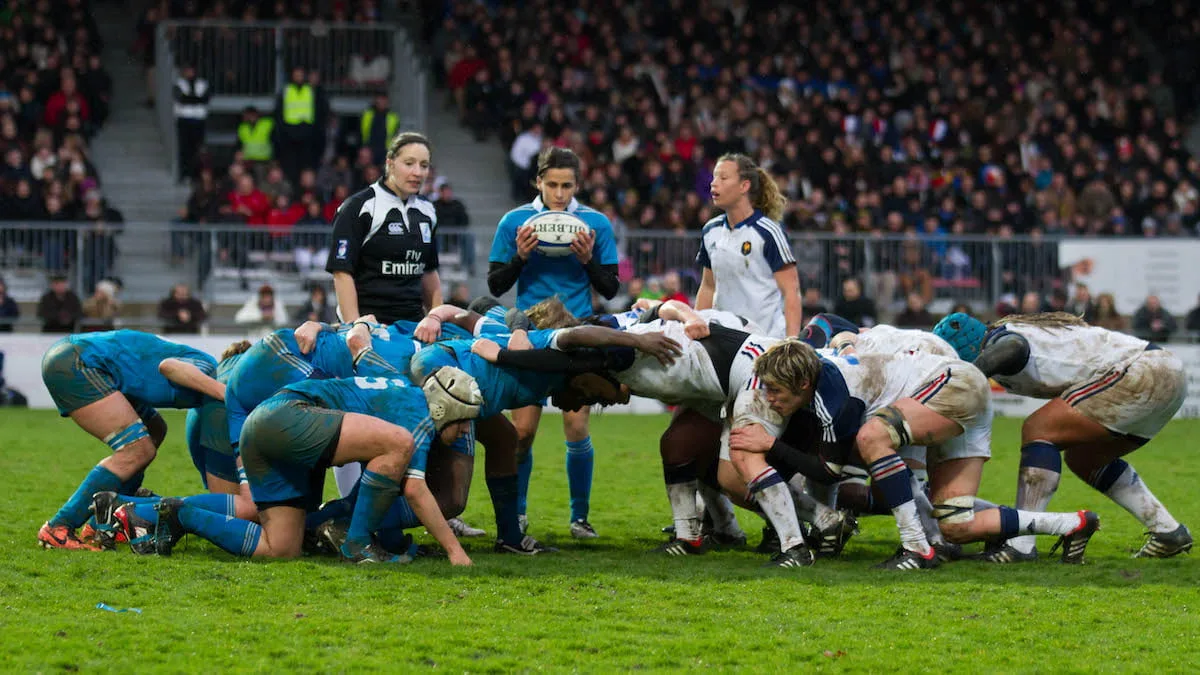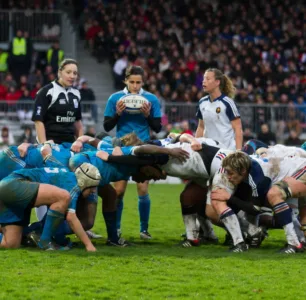A scrum is a set piece in rugby union where the forwards from both teams bind together and try to push their opponents backwards to win possession of the ball. The scrum is formed when the ball goes out of play or when a minor infringement occurs.
The scrum half from the team that did not cause the stoppage throws the ball in between the two packs of forwards and the two teams compete for the ball by trying to hook it backwards with their feet. The scrum is a key part of the game and requires a high level of teamwork, coordination, and technique from the forwards.
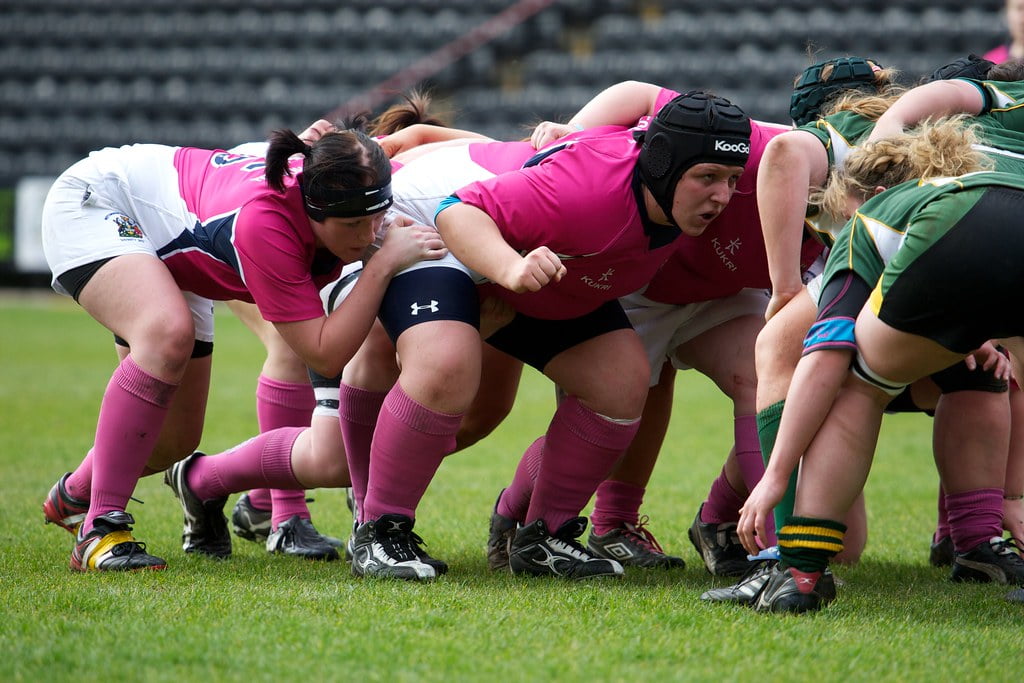
When is a scrum formed
A scrum is formed in rugby union when the ball goes out of play or when a minor infringement occurs. The ball must then be put back into play by the forwards of both teams binding together and contesting for possession through the scrum. The formation of a scrum restarts play and allows both teams to continue attacking and defending.
What infringements lead to a scrum
A scrum is formed in rugby union as a result of certain minor infringements, including:
- Forward pass: If the ball is passed forward from one player to another, a scrum is awarded to the non-offending team.
- Knock-on: If a player drops the ball and it goes forward, a scrum is awarded to the opposing team.
- Loss of control: If the ball is knocked out of a player’s control and goes into touch or into touch-in-goal, a scrum is awarded to the opposing team.
- Penalty: If a team commits a minor offence, such as not releasing the tackled player, a scrum can be awarded to the non-offending team.
- Infringement at the ruck or maul: If the rules at the ruck or maul are not followed, a scrum can be awarded to the non-offending team.
These infringements result in a scrum being formed, with the non-offending team having the option to choose either a scrum or a lineout. The scrum is a key aspect of rugby union and allows both teams to compete for possession and continue play
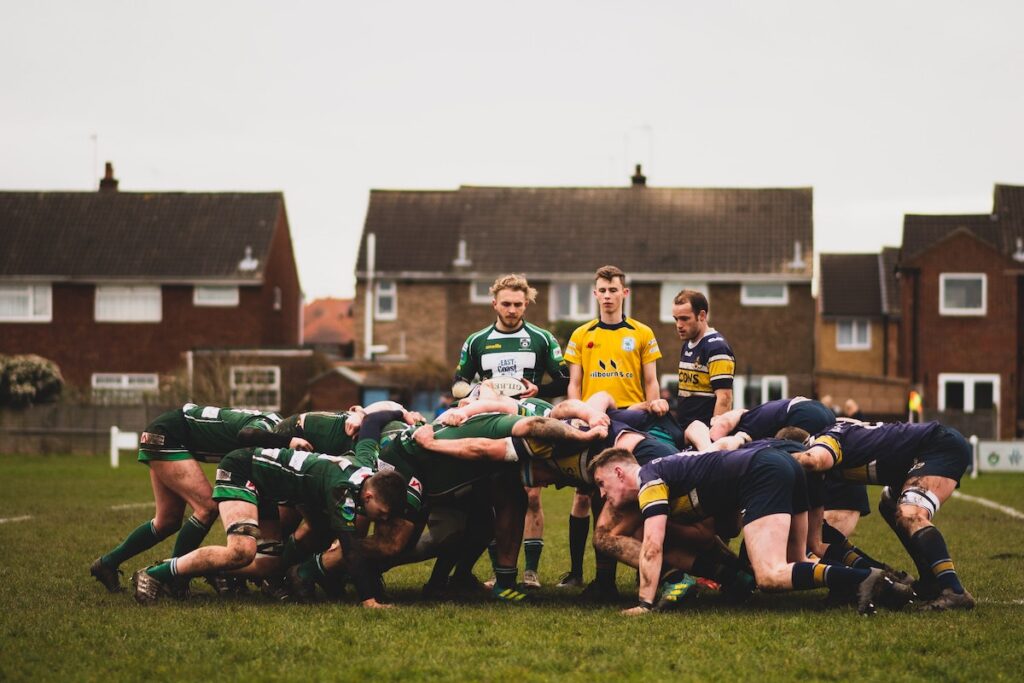
When is a scrum complete?
A scrum in rugby union is considered to be complete when one of the following events occurs:
- The ball is won by one of the teams: The objective of a scrum is to win possession of the ball, and once one of the teams has done so the scrum is complete.
- The ball becomes unplayable: If the ball becomes trapped in the scrum or is knocked out of the tunnel, the scrum is complete.
- The ball goes out of play: If the ball goes out of play or goes into touch, the scrum is complete.
- A reset: If the scrum collapses or the referee stops play, the scrum is reset.
Once the scrum is complete, play restarts with a pass from the scrumhalf, a run from the number 8, or with a lineout if the ball went into touch.
Who is involved in a scrum?
In a rugby union scrum, the following players are involved:
- The forwards: The scrum is contested by the forwards of both teams, who bind together in three rows of three or four players each. These are called the front row, second row and Back row.
- The scrumhalf: The scrumhalf from the team that did not cause the stoppage throws the ball in between the two packs of forwards.
- The referees: Two referees are present to manage the scrum, enforce the rules, and ensure that the contest is safe and fair.
In addition to these players, the other players on the field and the substitutes are also involved in the scrum, as they must be ready to react to the outcome of the contest and continue the game. The scrum is a crucial aspect of rugby union and requires the cooperation and coordination of all players on the field.
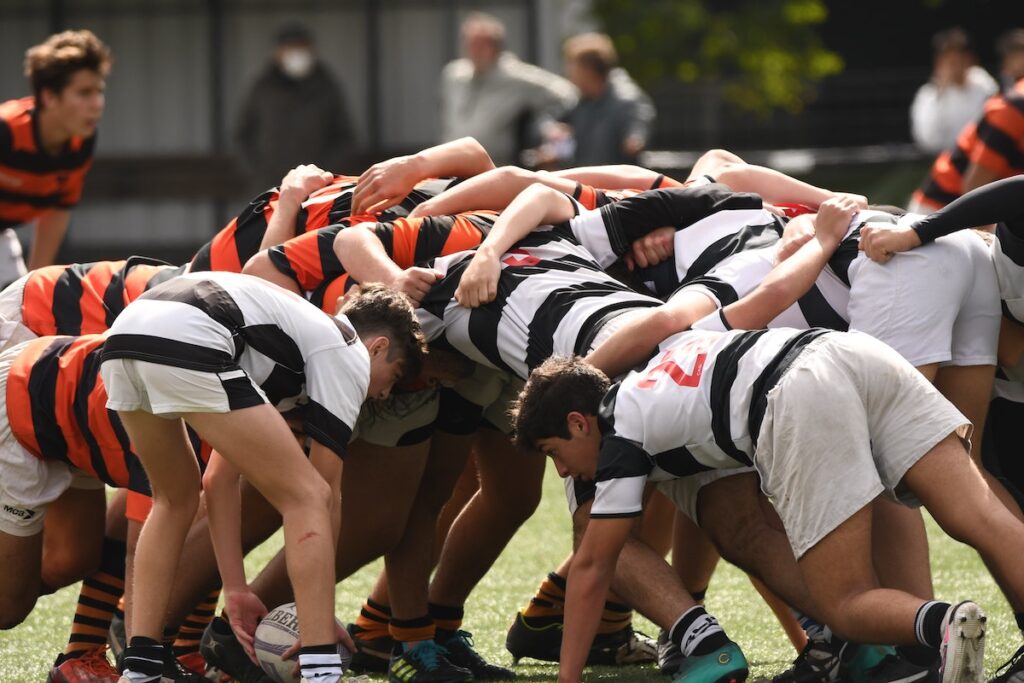
Who is in the front row of the scrum
The front row refers to the three forwards who form the front line of the scrum. The front row consists of the following positions:
- Loosehead prop: This player is positioned on the left side of the scrum and is responsible for providing stability and pushing power to the scrum.
- Hooker: This player is positioned in the middle of the front row and is responsible for striking for the ball with their feet and securing it for their team.
- Tighthead prop: This player is positioned on the right side of the scrum and is responsible for providing stability and pushing power to the scrum.
The front row is a key part of the scrum, as they provide the foundation for the rest of the forwards to contest for the ball. These players must be physically strong, technically skilled, and able to work together as a team to be successful in the scrum.
The Second row
The second row refers to the two forwards who form the second line of the scrum. The second row are also called locks. These players are positioned behind the front row and are responsible for providing height to the scrum and contesting for the ball at the back of the scrum.
The locks must be physically strong and technically skilled, as they play an important role in both the attack and defense of the scrum. They must work in close coordination with the front row to secure the ball and push their opponents backwards. The second row is also involved in the lineout, where they contest for the ball and provide an attacking platform for their team.
The back row
the back row refers to the three forwards who form the third line of the scrum. The back row consists of the following positions:
- Flankers: These players are positioned at the sides of the scrum and are responsible for disrupting the opposition’s ball, stealing the ball in the tackle, and supporting the attack.
- Number 8: This player is positioned at the back of the scrum and is responsible for securing the ball and linking play between the forwards and backs.
The back row must be physically strong and agile, as they play an important role in both the attack and defense of the scrum. They must be able to contest for the ball in the loose, support their teammates, and make tackles to prevent the opposition from scoring. The back row also provides valuable support to the rest of the team and helps to keep the play flowing.
The Scrum half
The scrum-half is the player who acts as the link between the forwards and backs. In a scrum, the scrum-half’s role is as follows:
- Throwing the ball in: The scrum-half from the team that did not cause the stoppage throws the ball in between the two packs of forwards.
- Controlling the ball: The scrum-half is responsible for retrieving the ball from the back of the scrum and making sure it is ready for the next phase of play.
- Communicating with the referee: The scrum-half must communicate with the referees to ensure that the scrum is set correctly and to make sure that any infringements are dealt with.
- Supporting the attack: Once the ball has been won, the scrum-half must be ready to take the pass from the back of the scrum and initiate the next phase of play.
The scrum-half plays a crucial role in the scrum, as they must be aware of the game situation and be ready to act quickly and effectively to get the ball moving. The scrum-half must work closely with the forwards and the rest of the team to ensure that the scrum is a successful platform for attack.
Scrum penalties
In rugby union, there are a number of different penalties that can be awarded during a scrum. Some of the most common scrum penalties are:
- Not straight: This penalty is awarded if the scrum is not straight or if one of the teams is pushing before the ball has been thrown in.
- Wheeling: This penalty is awarded if one of the packs of forwards turns the scrum around in an attempt to gain an advantage.
- Collapsing: This penalty is awarded if one of the packs of forwards collapses the scrum before the ball has been won.
- Dissent: This penalty is awarded if one of the players argues with the referee or shows dissent towards their decision.
- Offside: This penalty is awarded if a player is offside during the scrum and interferes with play.
- Dangerous play: This penalty is awarded if a player engages in dangerous play during the scrum, such as striking an opponent or lifting a player off the ground.
Penalties can have a significant impact on the outcome of the game, so it is important for players to be aware of the rules and to avoid committing any infringements during the scrum. If a penalty is awarded, the non-offending team will usually have the option of taking a scrum or a lineout, depending on the situation.
How to win a scrum
To win a scrum in rugby union, the following steps should be followed:
- Get into a good body position: Before the scrum, players should get into a good body position by crouching down and keeping their heads and shoulders over their knees. This will give them stability and help them to push effectively.
- Bind correctly: Players must bind onto their opposite player with both arms to create a stable platform for pushing.
- Drive together: The players must work together as a unit and drive forward, using their legs to generate power and push their opponents backwards.
- Communicate: Communication between the players is key to winning a scrum. Players should call out “heels” to signal that they are ready to engage, and use other calls to coordinate their efforts.
- Stay disciplined: Players must stay disciplined and avoid collapsing the scrum or committing any other infringements.
- Win the ball: The aim of the scrum is to win the ball, so players should focus on securing the ball and getting it back to the backs as quickly as possible.
A successful scrum requires good teamwork, technical skill, and a commitment to working together. By following these steps, players can help their team to win the scrum and get the ball moving towards the opposition’s try line.
